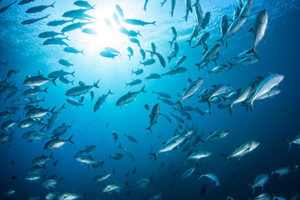The aquaculture and fishing industries have have historically flown under the radar with regard to animal cruelty as many people don’t think of fish as animals like cows or pigs. However, with the recent release of the groundbreaking documentary Seaspiracy, and an overall growing concern for climate change and ocean protection, the truth about these industries is beginning to come out. Here, we will break down the top five biggest misconceptions about fish and seafood.
Fish can’t feel pain or pleasure
Many people believe this because fishes look so drastically different from land animals, such as humans and companion animals, and therefore many don’t expect them to be capable of complex feelings and desires — or even of feeling pain. However, they are much more emotionally complex than what some humans assume. They have been shown to use tools, communicate, and some larger fish have even been shown to appreciate human affection. Fish have also been able to pass tests assessing self-awareness and cognitive ability.
Recent studies have confirmed that they feel pain in a significant way and have similar pain receptors to more advanced vertebrate species. This capacity for pain is nearly always ignored by fisheries, where fish are often killed in torturous and brutal ways, such as painful, slow suffocation.
Seafood is a necessary source of Omega-3s
Many of us have been told that consuming seafood provides necessary Omega-3 fatty acids and healthy protein. In reality, seafood consumption isn’t healthy — or humane. The super important fatty acids — the reason many people say seafood is such a necessity in the human diet — are not even produced by fishes themselves. They actually come from the plant-based algae that they consume. There are plenty of fish-free alternatives high in protein and Omega-3s such as Good Catch and Gardein Fishless. And you can find all the vegan recipes you’re looking for right here by searching our TryVeg recipes.
Fish prevent illness
Eating fish is often said to improve immunity and brain function, reducing one’s susceptibility to illnesses ranging from the common cold to dementia. However, it is extremely important to acknowledge that these benefits come from the Omega-3s and not the fish themselves. In reality, fish make us sick. Fish, specifically shellfish, are extremely high in cholesterol, known to cause heart disease in humans. Fish are often also full of toxins such as mercury and plastics. The amount of plastic that humans consume by way of seafood is only increasing with the more plastic waste humans dump into the oceans. Virus and toxin transmission from seafood is also common. The CDC recommends that certain fish should not be eaten at certain times of the year or at all given the presence of toxins in the fish. Given the COVID-19 pandemic, now more than ever before we should be concerned with the connection between agriculture and virus transmission.
Seafood is sustainable
Seafood is sometimes thought to be a more sustainable source of food, but this could not be further from the truth. The fishing industry often pushes the narrative that fishing can be made sustainable by ensuring that some areas are marine protected, but only about four to five percent of the ocean is given this protection and 90 percent of those areas still allow fishing. The massive nets used by commercial fisheries also wipe out acres of ocean plant ecosystems as well as catch much more than just fish including sea turtles, dolphins and sharks — this is known as “bycatch.” Wiping out ocean plants and ocean life, such as whales and phytoplankton, is damaging to the environment. Kelp forests not only serve as habitat and protection for smaller ocean organisms, but they also help prevent erosion by regulating the strength or storm driven tides. Seagrass and kelp also store large amounts of CO2 and their conservation and restoration are becoming a climate change prevention tactic. Many of the innocent animals that are caught as bycatch or wiped out by trawling nets also play important environmental roles. For example, phytoplankton produce 50% of the world’s oxygen. In addition to whales fertilizing phytoplankton, they also absorb tons of CO2 themselves. So if you’re concerned about the sustainability of your meals, it’s best to push seafood off the plate.
Farming fish is better for the fish and the environment
Given the information about trawling nets and bycatch, one might believe that farmed fish could be a more sustainable option, but this is not the case. Farmed fish often live in horrific conditions and wind up with anemia, lice infestations, chlamydia, painful deformities, and heart disease; many of these sick fish die but those who don’t are the same ones that wind up on your dinner plate. Fish farming can also lead to deforestation, as plots of forest have to be cleared out to make room for the factory farms.
Many farmed fish are given high doses of antibiotics which poses a health risk for humans and pollutes the oceans. Just like other farmed animals, fish are kept crammed in filthy conditions, forcing them to live in their own waste and unable to interact with their environment in a natural way. There is great debate about which is better — wild caught vs. farmed fish — but what is really best for sea creatures, humans and the planet, is to stop eating our finned friends altogether.


Comments 6
Great research concerning our fish!!
Once again, intentional ignorance catches up to us eventually!
Oh, my. I didn’t know this stuff!
The truth hurts
Daved Wachsman summons it up: “I find no difference between meat-eaters (meaters) and cannibals just the degree that’s all; flesh is flesh whether it comes from a human or animal”.
Thank You. Very good explanation.